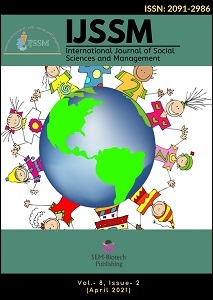Production Activities and Value Chain Analysis of Sericulture in Western Inner Terai Region of Nepal
DOI:
https://doi.org/10.3126/ijssm.v8i2.36614Keywords:
Value Chain, Sericulture, bivoltine, cocoon, silkAbstract
The study was conducted in Nov 2019 – Feb 2020 with the objective of assessing the whole value chain of sericulture products in the Western inner terai region of Nepal. The beginning of sericulture in the region was due to some personal interest but gained popularity and huge return and turned out to achieve the objectives of food security and source of employment. As per the finding and research, Bi-voltine Silkworm (Bombyx mori) was mainly reared which feeds upon the leaves of the mulberry plant. The interview result indicates that producers produce cocoon at an average of 30.05 kg per ropani in one production round and production was made twice a year. In this region, three marketing channels were identified (producer to the primary collector/small hand processor) and (producer to primary processor or reelers) and the producer himself as the processor and distributor. Producers sold the cocoon to primary collectors at NRs 500per kg cocoon which was 15% more than percent sales while selling to the government, fetching an average BC ratio of 1.3. Problems recorded as per farmers were lack of appropriate technology to widen the scope of sericulture and modern silkworm rearing techniques, lack of proper irrigation facilities, and governmental aids and support. This research will address various problems and make an emphasis to make regional sericulture production mature and profitable.
Downloads
Downloads
Published
How to Cite
Issue
Section
License
This license enables reusers to distribute, remix, adapt, and build upon the material in any medium or format for noncommercial purposes only, and only so long as attribution is given to the creator.




